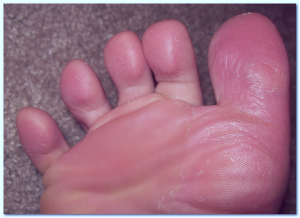Skin peeling between toes is a very common problem faced by many people on a regular basis. This may also be accompanied by some other symptoms like itching or blister formation. Sometimes it may just be a natural process of removal of upper layer of skin and its replacement by new skin which lies underneath. The various reasons which can attribute to this skin peeling between your toes include:
Athlete’s foot
Also known as tenia pedis, it is most usually caused due to a fungal infection and manifests itself as a rash on the skin of foot. The fungus grows in the moist and warm environment such as the space between two toes of the foot. The infection gets transmitted easily by contact with the infected person or it may also spread by walking barefoot on a contaminated surface such as a poolside. The symptoms vary according to the type of infection, but the general symptoms include itching, scaly skin or blisters, pain and discomfort.
They are of three types:
1) moccasin type, on the soles of feet
2) interdigital, between the toes and
3) inflammatory type, which causes blisters.
The diagnosis is generally by symptoms and history of fungal infections. If the treatment doesn’t work, then the doctor may suggest you to get a culture test done for the fungi.
This condition can be prevented by using cotton socks and shoes which allow skin breathing.
Environmental factor and dehydration
When the skin of your feet gets too dry or loses its moisture, such as in winters or summers, it can result in itching and dry skin, causing it to peel off. In summers, when you need to take regular baths for more than two times a day, it can result in the loss of your body’s natural oils from the skin, causing excessive dryness. It is necessary to maintain the moisture of your skin in such conditions by regular moisturisation using creams and lotions.
Toe Box dermatitis
It is also known as shoe contact dermatitis. This is caused due to two reasons. One is the reaction to some particular allergen or substance present in the shoe, like rubber, leather or some similar product which is involved in the design of the shoe. Second is that the toe or toes don’t get enough space and ventilation for the foot to breathe, thereby causing irritation due to entrapment of heat and moisture.
The irritation usually begins on the big toe and spreads to the other toes. The irritation may also be present on the sole of the foot or side of feet and heels. Symptoms include swelling, itching, blister formation, burning and pain.
Allergic reaction
Your skin can also start to peel off if it is allergic to some of the product which is in contact with your toes regularly. This can include any of the material of your shoe or slipper or it can also occur while you are walking barefoot in some public areas.
Psoriasis
It is a chronic disease affecting the skin causing it to grow too quickly, resulting in patchy flaked and peeling skin. The skin is covered by a scaly, white to silver patch of dead skin which eventually falls off and another layer of such skin is formed. The patches may range from very small ones to the ones covering huge areas of the skin. They are more commonly seen on the scalp, toes, elbow, knees hands and feet. This disease is not communicable and the symptoms may go into remission by itself and reappear itself later. The condition is managed by keeping the skin moist using moisturisers and avoiding exposure to sun and UV light. One should also take care to avoid exposure to the things that can worsen the conditions.
Trench foot
It is an unusual condition caused by prolonged exposure of the foot to cold, damp and unsanitary conditions. The affected feet loses its sensation and may turn get cyanosed (turning blue) or may turn red. The feet also have a decaying odour. This is because of the obstruction or blockage of blood supply to the foot. Due to which, the foot undergoes necrosis and gives off the decaying smell. In advanced stages, it causes blisters and open sores in the foot, which can further be prone to fungal and bacterial infections. If untreated for a long time, it can result in gangrene and the further need for amputation of the affected foot. It differs from frostbite, which requires freezing temperatures. It can occur in temperatures around 16 degrees Celsius.
The skin peeling between your toes should be taken care of otherwise it can worsen to cause deeper infections like cellulitis. Cellulitis is an inflammation of the connective tissue which lies under the skin and it spreads rapidly. It is also more difficult to treat and cure.

